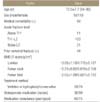Abstract
Purpose
To evaluate the risk factors for subsequent vertebral fracture following acute osteoporotic vertebral compression fracture.
Materials and Methods
This was a multicenter retrospective study. We recruited 135 patients treated for acute osteoporotic compression fracture with available spine image taken at the 1-year follow-up mark in 3 different hospitals. The patients were divided into 2 groups in accordance with the occurrence of subsequent vertebral fracture. Variables including age, sex, bone mineral density, medical comorbidity, acute fracture level, presence of prior vertebral fracture, osteoporosis medication, and treatment method were analyzed and compared between the 2 groups.
Results
The new subsequent vertebral fractures were detected in 25 patients (18.5%). There were no significant differences between the 2 groups with respect to age, sex, medical comorbidity, presence of prior vertebral fracture, and acute fracture level, as shown by univariate analysis. However, in the group with subsequent vertebral fracture, more patients were treated by vertebroplasty or kyphoplasty and had a femur neck T-score of ≤-2.5, as well as poor compliance of osteoporosis medication with significant difference (p<0.05). According to the multivariate analysis, subsequent vertebral fractures were significantly influenced by vertebroplasty or kyphoplasty (p=0.003, odds ratio=4.71) and femur neck T-score of ≤-2.5 (p=0.013, odds ratio=3.47).
Figures and Tables
References
1. Borgström F, Zethraeus N, Johnell O, et al. Costs and quality of life associated with osteoporosis-related fractures in Sweden. Osteoporos Int. 2006; 17:637–650.

2. Johnell O, Kanis JA. An estimate of the worldwide prevalence and disability associated with osteoporotic fractures. Osteoporos Int. 2006; 17:1726–1733.

3. Kim JH, Kim SS, Lee DH, et al. Analysis of treatment methods for subsequent vertebral fractures following osteoporotic compression fractures. J Korean Soc Spine Surg. 2015; 22:75–81.

4. Zhao QM, Gu XF, Liu ZT, Cheng L. The value of radionuclide bone imaging in defining fresh fractures among osteoporotic vertebral compression fractures. J Craniofac Surg. 2016; 27:745–748.

5. Guermazi A, Mohr A, Grigorian M, Taouli B, Genant HK. Identification of vertebral fractures in osteoporosis. Semin Musculoskelet Radiol. 2002; 6:241–252.

6. Siris ES, Selby PL, Saag KG, Borgström F, Herings RM, Silverman SL. Impact of osteoporosis treatment adherence on fracture rates in North America and Europe. Am J Med. 2009; 122:S3–S13.

7. Rousing R, Hansen KL, Andersen MO, Jespersen SM, Thomsen K, Lauritsen JM. Twelve-months follow-up in forty-nine patients with acute/semiacute osteoporotic vertebral fractures treated conservatively or with percutaneous vertebroplasty: a clinical randomized study. Spine (Phila Pa 1976). 2010; 35:478–482.
8. Kang SK, Lee CW, Park NK, et al. Predictive risk factors for refracture after percutaneous vertebroplasty. Ann Rehabil Med. 2011; 35:844–851.

9. Lindsay R, Silverman SL, Cooper C, et al. Risk of new vertebral fracture in the year following a fracture. JAMA. 2001; 285:320–323.

10. Yen CH, Teng MM, Yuan WH, Sun YC, Chang CY. Preventive vertebroplasty for adjacent vertebral bodies: a good solution to reduce adjacent vertebral fracture after percutaneous vertebroplasty. AJNR Am J Neuroradiol. 2012; 33:826–832.

11. Li YA, Lin CL, Chang MC, Liu CL, Chen TH, Lai SC. Subsequent vertebral fracture after vertebroplasty: incidence and analysis of risk factors. Spine (Phila Pa 1976). 2012; 37:179–183.
12. Baroud G, Heini P, Nemes J, Bohner M, Ferguson S, Steffen T. Biomechanical explanation of adjacent fractures following vertebroplasty. Radiology. 2003; 229:606–607. author reply 607-8.
13. Baroud G, Nemes J, Heini P, Steffen T. Load shift of the intervertebral disc after a vertebroplasty: a finite-element study. Eur Spine J. 2003; 12:421–426.





 PDF
PDF ePub
ePub Citation
Citation Print
Print





 XML Download
XML Download